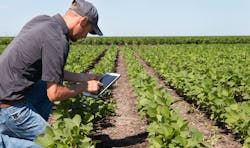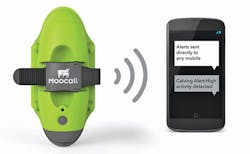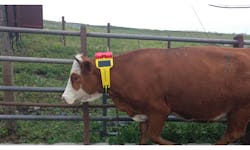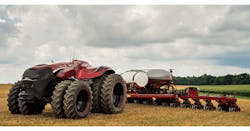Download this article in PDF format.
When we think of Internet of Things (IoT) applications, growing crops or raising livestock aren’t the first visuals that come to mind. Yet the smart agriculture market is expected to grow from $5.18 billion in 2016 to $11.23 billion by 2022, according to Markets and Markets. That translates into a compound annual growth rate (CAGR) of 13.27% between 2017 and 2022.
Farms are becoming more connected as farmers realize the potential of IoT technologies in helping them minimize operation cost while still achieving better results. Examples include higher crops, lower livestock losses, and less water usage. To help improve farm performance, IoT technology providers continue to develop platforms that can sense, process, and communicate precisely measured environmental data. Behind these IoT platforms is an array of technologies that includes sensing, microcontrollers, transmitters, energy harvesting, LED lights, drones, and more.
What follows are three smart farming applications already in play that take advantage of these technology solutions:
1. Livestock monitoring
Here, the IoT allows the entire livestock environment to be constantly monitored. The user is alerted by phone, text, or email if any condition falls outside of a preset parameter. Several systems containing some of the elements of an integrated monitoring system are now available commercially for swine, cattle, broiler, and milk production.
1. Moocall works anywhere in the world with GSM signal (Courtesy of Moocall)
For example, a company called Moocall helps farmers monitor pregnant cows that are preparing to give birth. A battery-powered sensor detects motion associated with oncoming labor and then sends an alert SMS notification (Fig. 1). The battery lasts for up to 60 days; the device will send an alert when the battery level drops to 15%. The calving sensor is equipped with an embedded machine-to-machine (M2M) chip that can work over different networks.
Another livestock monitoring application is CattleWatch. This cloud-based hardware/software technology utilizes energy harvesting to power sensor and communication platforms to remotely monitor the health status and location of livestock. As a result, users have access to real-time data from their homes or offices or by smartphone. The CattleWatch system (Fig. 2) deploys hub collars that are placed on roughly 2% of the cattle. The remainder of the herd is outfitted with collar units or ear tags powered primarily by lithium batteries.
The hub collars feature miniaturized photovoltaic cells that harvest solar energy, which is then stored in Tadiran TLI Series industrial-grade lithium-ion (Li-ion) rechargeable batteries. TLI Series Li-ion batteries can operate for up to 20 years and 5,000 full recharge cycles, with an extended temperature range of −40 to 85°C and storage of up to 90°C. They’re able to deliver high pulses (up to 15 A and 5 A continuous) so that the hub collars can communicate wirelessly with the Iridium satellite network.
2. The CattleWatch system even broadcasts alerts if predatory animals or poachers are detected. (Courtesy of CattleWatch)
All of the regular collars communicate with the solar-powered hub collars to create an in-herd wireless mesh network. It provides valuable, near-real-time insight regarding animal behavior, including herd location, walking time, grazing time, resting time, water consumption, in-heat condition, and other health events. The system even broadcasts alerts upon detection of predatory animals or poachers.
2. Precision farming
With rugged and precise IoT sensors, farmers can collect data on weather, soil, air quality, and crop maturity, enabling them to make smarter decisions. For instance, a company called Cropx uses data and sensor devices to help farmers better understand water usage across their fields. The company also informs farmers about the amount of fertilizer and pesticide needed by each patch at specific times, automatically handling daily decisions for farmers. Algorithms and pattern-recognition technology are used to analyze the farmland and determine the various elevations (where they are hilly or flat).
“I think that it’s very important to distinguish between data that is coming from above the soil and data coming from below,” said Tomer Tzach, Cropx CEO, at the Forbes AgTech Summit. “Data from above the soil is coming from drones, satellite imagery, pictures that are coming from cameras that are put on weather stations, and so forth. And when you take imagery, you’re always too little, too late because by the time you see something, it’s already happening and the plant is already suffering. It’s a much bigger challenge getting the data out of there, but I think that the data coming out of [the soil] can be much more useful in terms of being predictive.”
Analog Devices Inc. (ADI) has been working on a very interesting project called “The Internet of Tomatoes” in its offices in Wilmington, Mass. This precision agriculture experiment leverages technologies like microelectromechanical systems (MEMS) and sensors. ADI integrates hardware solutions with a cloud-based IoT application from ThingWorx to develop a complete solution for farmers, providing them with apps and dashboards built on ThingWorx to better understand and implement improvements.
3. Autonomous tractors
Tractor manufacturers like John Deere and Case IH offer tractors to farmers that drive automatically. Self-driving tractors have been in the market for many years—even longer than semi-autonomous cars on the roads. One advantage of self-driving tractors is their ability to avoid reworking the same crop row by reducing the overlap to less than an inch. As a result, it takes fewer passes to cover each field, therefore saving farmers time and money. In addition, they can make very precise turns without the driver even touching the steering wheel.
Full autonomous tractors navigate using lasers that bounce signals off several mobile transponders located around the field. With supervised tractors, in contrast, a tractor is driven by a person, but followed by autonomous machinery. That machinery copies the steering and speed of the first tractor. This type of tractor offers the advantage of a reduction in human errors when performing tasks like spraying insecticide.
3. Case IH’s concept tractor uses onboard video cameras and LiDAR (light imaging, detection and ranging) sensors to identify obstacles in its path.
At the moment, no autonomous tractors exist on the market—but all major tractor makers have them in the works. For instance, Case IH (Fig. 3) planted soybeans with its concept autonomous tractor, and is taking the machine on a world tour to put it on display at farm shows. This driverless tractor won’t be available in the marketplace for at least a few years. However, through experiments and showing it to real-world farmers, manufacturers are getting a better idea of what features and capabilities are desired in an autonomous tractor.
As advances push forward in IoT applications—ranging from enhanced battery-storage technology to the production of more complete IoT solutions from semiconductor companies—connected farms are destined to become more efficient and more productive. Not every farmer agrees with using these technologies, despite the fact that they offer real benefits to farmers. Maybe in the future, as IoT technologies mature, reticent farmers will realize how they can make such solutions adapt to their specific needs.
About the Author
Maria Guerra
Contributing Editor
Maria Guerra is the Power/Analog Editor for Electronic Design and occasional Technical Contributor to Machine Design. She is an Electrical Engineer with an MSEE from NYU Tandon School of Engineering. She has a very solid engineering background and extensive experience with technical documentation and writing. Before joining Electronic Design, she was an Electrical Engineer for Kellogg, Brown & Root Ltd (London. U.K.). During her years in the Oil and Gas Industry she was involved in a range of projects for both offshore and onshore designs. Her technical and soft skills bring a practical, hands-on approach to the Electronic Design team.




